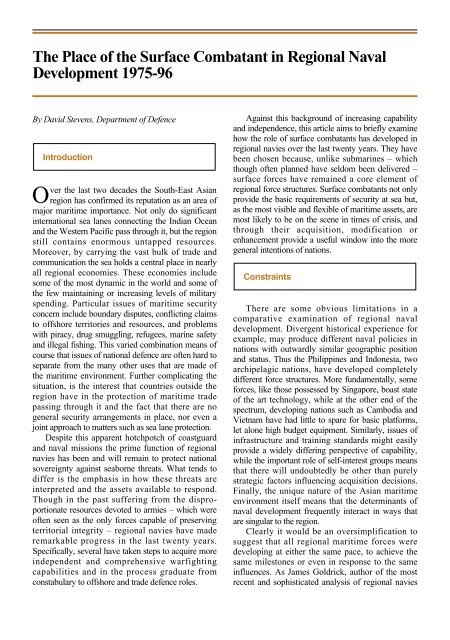ISSUE 125 : Jul/Aug - 1997 - Australian Defence Force Journal
ISSUE 125 : Jul/Aug - 1997 - Australian Defence Force Journal
ISSUE 125 : Jul/Aug - 1997 - Australian Defence Force Journal
You also want an ePaper? Increase the reach of your titles
YUMPU automatically turns print PDFs into web optimized ePapers that Google loves.
The Place of the Surface Combatant in Regional NavalDevelopment 1975-96By David Stevens, Department of <strong>Defence</strong>IntroductionOver the last two decades the South-East Asianregion has confirmed its reputation as an area ofmajor maritime importance. Not only do significantinternational sea lanes connecting the Indian Oceanand the Western Pacific pass through it, but the regionstill contains enormous untapped resources.Moreover, by carrying the vast bulk of trade andcommunication the sea holds a central place in nearlyall regional economies. These economies includesome of the most dynamic in the world and some ofthe few maintaining or increasing levels of militaryspending. Particular issues of maritime securityconcern include boundary disputes, conflicting claimsto offshore territories and resources, and problemswith piracy, drug smuggling, refugees, marine safetyand illegal fishing. This varied combination means ofcourse that issues of national defence are often hard toseparate from the many other uses that are made ofthe maritime environment. Further complicating thesituation, is the interest that countries outside theregion have in the protection of maritime tradepassing through it and the fact that there are nogeneral security arrangements in place, nor even ajoint approach to matters such as sea lane protection.Despite this apparent hotchpotch of coastguardand naval missions the prime function of regionalnavies has been and will remain to protect nationalsovereignty against seaborne threats. What tends todiffer is the emphasis in how these threats areinterpreted and the assets available to respond.Though in the past suffering from the disproportionateresources devoted to armies – which wereoften seen as the only forces capable of preservingterritorial integrity – regional navies have maderemarkable progress in the last twenty years.Specifically, several have taken steps to acquire moreindependent and comprehensive warfightingcapabilities and in the process graduate fromconstabulary to offshore and trade defence roles.Against this background of increasing capabilityand independence, this article aims to briefly examinehow the role of surface combatants has developed inregional navies over the last twenty years. They havebeen chosen because, unlike submarines – whichthough often planned have seldom been delivered –surface forces have remained a core element ofregional force structures. Surface combatants not onlyprovide the basic requirements of security at sea but,as the most visible and flexible of maritime assets, aremost likely to be on the scene in times of crisis, andthrough their acquisition, modification orenhancement provide a useful window into the moregeneral intentions of nations.ConstraintsThere are some obvious limitations in acomparative examination of regional navaldevelopment. Divergent historical experience forexample, may produce different naval policies innations with outwardly similar geographic positionand status. Thus the Philippines and Indonesia, twoarchipelagic nations, have developed completelydifferent force structures. More fundamentally, someforces, like those possessed by Singapore, boast stateof the art technology, while at the other end of thespectrum, developing nations such as Cambodia andVietnam have had little to spare for basic platforms,let alone high budget equipment. Similarly, issues ofinfrastructure and training standards might easilyprovide a widely differing perspective of capability,while the important role of self-interest groups meansthat there will undoubtedly be other than purelystrategic factors influencing acquisition decisions.Finally, the unique nature of the Asian maritimeenvironment itself means that the determinants ofnaval development frequently interact in ways thatare singular to the region.Clearly it would be an oversimplification tosuggest that all regional maritime forces weredeveloping at either the same pace, to achieve thesame milestones or even in response to the sameinfluences. As James Goldrick, author of the mostrecent and sophisticated analysis of regional navies
















